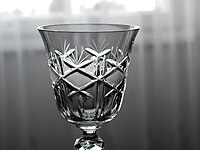
Photo from wikipedia
Abstract With the rapid advances of the electronic industry, the management of the cathode ray tube (CRT) glass waste has become a major environmental problem. In this study, the CRT… Click to show full abstract
Abstract With the rapid advances of the electronic industry, the management of the cathode ray tube (CRT) glass waste has become a major environmental problem. In this study, the CRT funnel glass sand untreated with nitric acid (n-TFG) and treated with nitric acid (TFG) were used to replace river sand as fine aggregate for the production of the mortar. The TFG glass sand series mortars exhibit the worse fluidity and fluidity preservation, the shorter setting times, the lower wet density and mechanical properties than those with n-TFG glass sand. The use of TFG glass sand in the mortar also results in the lower drying shrinkage, alkali-silica reaction (ASR) expansion and leaching content of lead than the blended n-TFG glass sand mortars. Moreover, at the drying shrinkage period of 56 days, the drying shrinkage values of the mortars with TFG glass sand are within the limit of 0.075%. The mortars prepared by TFG glass sand have a low ASR expansion, at the tested age of 14 days, which are below permissible limits (0.10%). The lead leaching of the mortars with TFG glass sand comply with the regulatory limits.
Journal Title: Construction and Building Materials
Year Published: 2017
Link to full text (if available)
Share on Social Media: Sign Up to like & get
recommendations!